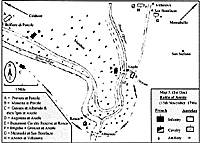 The 1st Day: 15th November 1796. (see Map 3 at right)
The 1st Day: 15th November 1796. (see Map 3 at right)
Once across the bridge at Ronco the road turns to the left and right. To the left the road led to the village of Belfiore di Porcile and eventually the rear of the Austrian positions at Caldiero.
Large Map 3 (slow download: 68K)
The right turn follows the path of the Adige for a while before curving upwards along the west bank of the Alpone as far as Arcola. Here it crossed the Alpone via a wooden bridge to the east bank and then heads northwards again until it reaches Villanova via San Bonifacio.
Augereau's Division turned right and advanced towards Arcola, while Massena advanced towards Porcile. Massena's objective was to secure the bridgehead at Ronco and threaten Alvinci's left rear. Augereau aimed to cut Alvinci's line of retreat at Villanova and then attack any parks and supply convoys.
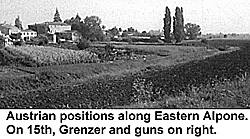 Halfway to his objective, Massena's Division bumped into a regiment sent by Alvinci and after some fierce fighting drove the Austrians back as far as Porcile. This, for now, secured the left side of the Ronco bridgehead. Augereau's Division wasn't so lucky, advancing along the dike road they came under heavy fire from two battalions of Croat Grenzer with two guns on the eastern bank of the Alpone. The Austrians had a clear sight of the French advance for at least a mile and when the French eventually reached Arcola they were met with heavy resistance from more infantry and artillery under Brigido.
Halfway to his objective, Massena's Division bumped into a regiment sent by Alvinci and after some fierce fighting drove the Austrians back as far as Porcile. This, for now, secured the left side of the Ronco bridgehead. Augereau's Division wasn't so lucky, advancing along the dike road they came under heavy fire from two battalions of Croat Grenzer with two guns on the eastern bank of the Alpone. The Austrians had a clear sight of the French advance for at least a mile and when the French eventually reached Arcola they were met with heavy resistance from more infantry and artillery under Brigido.
Despite Augereau personally leading an attack, they were further repulsed with heavy losses. Even if they did manage to cross the bridge, there was another obstacle in the form of a narrow, steep sided stream, between Arcola and the Alpone. Although not much of an obstruction to cavalry and skirmishers, it was big enough to break up close formations and prevent the movement of artillery.
Not a Total Surprise
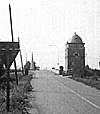 The French advance wasn't the total surprise they planned because Alvinci had been warned earlier in the day that the French had crossed at Ronco, but due to the marshy area he dismissed it as only a diversion. Once he learnt the truth he sent Provera with 3,000 men to Porcile. It was the advance guard of this force that Massena had bumped into. Unfortunately for the Austrians, Provera set about containing the French rather than attacking them, probably in an attempt to secure Alvinci's rear as ordered. Alvinci also sent GM Metrouski (sometimes spelt Mittrowsky) with around 3,500 men from San Bonifacio to strengthen the position at Arcola.
The French advance wasn't the total surprise they planned because Alvinci had been warned earlier in the day that the French had crossed at Ronco, but due to the marshy area he dismissed it as only a diversion. Once he learnt the truth he sent Provera with 3,000 men to Porcile. It was the advance guard of this force that Massena had bumped into. Unfortunately for the Austrians, Provera set about containing the French rather than attacking them, probably in an attempt to secure Alvinci's rear as ordered. Alvinci also sent GM Metrouski (sometimes spelt Mittrowsky) with around 3,500 men from San Bonifacio to strengthen the position at Arcola.
Metrouski, arriving just after the repulse of Augereau's Division, immediately ordered a counterattack, but was beaten back, although the French still failed to capture the bridge. Napoleon arrived and ordered another attack. This also failed, so, grabbing a flag (said to be the standard of the 51st Line Demi-Brigade) and accompanied by his generals, Napoleon led another charge across the bridge. But this assault was also repulsed with heavy casualties, the Austrians counterattacked again and in the confusion Napoleon was swept into the marshes as the French troops retreated. Only a charge by the Grenadiers, organised by a staff officer, possibly Belliard, saved him from being captured.
It was here that Lannes, already injured in previous actions, received several more wounds protecting Napoleon. It was getting late but Guyeux's brigade, sent by Vaubois from Rivoli, arrived at Ronco and was immediately ordered to cross the Alpone at Albaredo. He was then to advance northwards and take the Austrians at Arcola in their left flank. Due to heavy going he didn't reach Arcola until around 7 pm and took the village at bayonet point. At this time, from the top of a church tower in Ronco, the Austrians could be seen retreating through the Villanova defile to take up a new position east of the Alpone.
Napoleon Leads the Charge
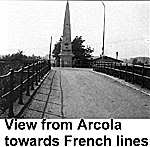 The first day's fighting was over. Although the French losses had been heavy at Arcola, the Austrians had suffered more with severe losses at both Porcile and Arcola. The French still failed to capture the bridge. Napoleon arrived and ordered another attack. This failed, so, grabbing a flag (said to be the standard of the 51st Line Demi-Brigade) and accompanied by his generals, Napoleon led another charge across the bridge. But this assault was also repulsed with heavy casualties.
The first day's fighting was over. Although the French losses had been heavy at Arcola, the Austrians had suffered more with severe losses at both Porcile and Arcola. The French still failed to capture the bridge. Napoleon arrived and ordered another attack. This failed, so, grabbing a flag (said to be the standard of the 51st Line Demi-Brigade) and accompanied by his generals, Napoleon led another charge across the bridge. But this assault was also repulsed with heavy casualties.
The Austrians counterattacked yet again and in the confusion Napoleon was swept into the marshes as the French troops retreated. Only a charge by the Grenadiers, organised by a staff officer, possibly Belliard, saved him from being captured, it was here that Lannes, already wounded from previous actions, received several more protecting Napoleon's body. It was getting late but Guyeux's brigade, sent by Vaubois from Rivoli, arrived at Ronco and was immediately ordered to cross the Alpone at Albaredo.
He was then to advance northwards and take the Austrians at Arcola in their left flank. But due to heavy going he didn't reach Arcola until around 7 pm and took the village at bayonet point. At this time, from the top of a church tower in Ronco, the Austrians could be seen retreating through the Villanova defile to take up a new position east of the Alpone. The first days fighting was over. Although the French losses had been heavy at Arcola, the Austrians had suffered more with severe losses at both Porcile and Arcola.
Overall, Napoleon had failed in his initial plan of cutting Alvinci's line of communication and attacking his parks and supply convoys. He had succeeded in forcing him to fight in the marshes and prevented his union with Davidovitch. As night approached bad news arrived, during the action at Arcola, Davidovitch had finally attacked Vaubois at Rivoli and forced him to retreat to Bussolengo. If he attacked again he might break through and become a threat to the rear of Napoleon's position at Ronco.
In order to be able to assist Vaubois if needed, he pulled all the French units back to the west bank of the Adige. Only a few troops were left to hold the Ronco bridgehead, and the camp fires were left burning at Arcola to fool the Austrians into thinking that the French were still there. Finally, Napoleon ordered Kilmaine to send his reserve brigade from Mantua to Ronco to strengthen the French attacking force. All was set for day two.
The 2nd Day. 16th November
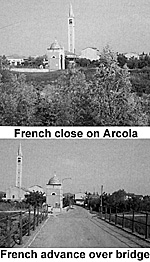 At 4 am the French, ready to march to aid Vaubois, received news that Davidovitch had not pressed his attack. This gave Napoleon another day to attempt to defeat Alvinci and he ordered Massena and Augereau to cross the Adige once more. The Austrians meanwhile, found Arcola and Porcile empty and Provera and Metrouski promptly occupied them. Then, leaving one Division commanded by Hohenzollern to hold Villanova, they advanced with the mutual aim of destroying the French bridgehead at Ronco.
At 4 am the French, ready to march to aid Vaubois, received news that Davidovitch had not pressed his attack. This gave Napoleon another day to attempt to defeat Alvinci and he ordered Massena and Augereau to cross the Adige once more. The Austrians meanwhile, found Arcola and Porcile empty and Provera and Metrouski promptly occupied them. Then, leaving one Division commanded by Hohenzollern to hold Villanova, they advanced with the mutual aim of destroying the French bridgehead at Ronco.
Massena managed to defeat Provera's column and retook Porcile. Augereau's Division, however, again suffered badly and were being pushed back by the Austrians. When Metrouski's command spotted Provera's column retreating, they lost heart and began to retreat. Augereau's men advanced again only to be ambushed by a battalion of Grenzer Croats and were again forced to fall back with heavy losses. GM Metrouski then used the lull in fighting to stiffen the defences of Arcola.
Part of the defence included the 1st Battalion IR4 and a battalion of Karlstadt Grenzer placed on the east bank of the Alpone below Arcola. These were to fire with great effect into the open flank of the numerous French attacks that followed. The French even tried to cross over the Adige where Guyeux had crossed by using fascines, failing because of the strong current. As night approached the French tried once more but were forced to retreat due to the fierce Austrian resistance, losing several guns in the process. Reluctantly, Napoleon ordered all his troops back over the Adige to take up their positions of the previous night. Again one Demi-brigade was left to hold the Ronco bridgehead.
It appeared that during the second day's fighting the Austrians again lost more men than the French. If this is correct then most of these must have surely been caused by Massena's Division. News reached Napoleon that Vaubois was still at Bussolengo and this gave him yet another chance to try and defeat Alvinci. Although pushed back, the fighting on the 16th had somewhat boosted the French morale, which was further increased with the recent arrival of Kilmaine' reserve brigade.
This raised Napoleon's attacking force to around 16,500. French optimism was raised when it was worked out that, due to the losses occurred over the two days fighting, it was possible the Austrians no longer held numerical superiority. During the night Napoleon ordered a trestle bridge to be built over the Alpone in front of Albaredo, troops crossing earlier by boat to cover its building, met no resistance.
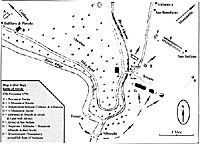 The 3rd Day: 17th November: (see Map 4)
The 3rd Day: 17th November: (see Map 4)
The third day of fighting found the Austrian army still divided, Provera and Hohenzollern were on one side of the Arcola marshes and Alvinci was on the other. In a sense Hohenzollern was like an Austrian Grouchy, he must have been able to hear the sounds of battle both to the Southwest and east of his position, yet he failed to join in the action.
Large Map 4 (slow download: 63K)
Should he have continued (like Grouchy at Waterloo) to obey orders and remain where he was or should he have aided Alvinci or Provera? It's just possible that any action on his behalf may well have altered the whole outcome of the battle.
But he didn't move and Napoleon wasn't slow in working out that if they acted quickly enough it was clear the Austrians still wouldn't be able to support each other. Napoleon now decided to use his favourite tactic of concentrating his troops to outnumber and defeat one enemy while holding off another. Massena was ordered to block the Porcile road with one brigade, while he and the rest of his Division would advance up the dike road to attack Arcola.
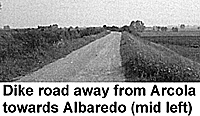 Augereau and all the remaining troops were to cross the Alpone via the bridge at Albaredo and to attack the Austrian left flank. The unused French cavalry were to follow behind Augereau, and the French garrison troops at Legnago (Legnano), consisting of two battalions and four guns, were to make a diversion further to the east around the Austrian left flank.
Augereau and all the remaining troops were to cross the Alpone via the bridge at Albaredo and to attack the Austrian left flank. The unused French cavalry were to follow behind Augereau, and the French garrison troops at Legnago (Legnano), consisting of two battalions and four guns, were to make a diversion further to the east around the Austrian left flank.
Unfortunately for the Austrians, as the rain fell yet again, they were completely unaware of the storm within a storm that was about to be unleashed upon them. Owing to a false report on the night of the 16th which said the French were falling back to Mantua, only a small rearguard remained at the Ronco bridgehead. They advanced towards the advancing French, and luckily for them the bridge broke just as Massena's Division started to cross. The unfortunate French soldiers trapped on the eastern bank, were saved from annihilation by the firepower of some of their own artillery which kept the advancing rearguard at bay.
Bridge Repaired
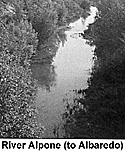 Once the bridge was repaired, at around 9 am, the French advanced as planned. One of Massena's brigades pushed the Austrians back to Porcile while the other, commanded by General Robert, advanced towards Arcola. Massena had the remainder of his Division hide amongst some willows near the bridge. Metrouski commanding the Austrians attacked again and pushed the French back to Ronco but were ambushed by the hidden troops.
Once the bridge was repaired, at around 9 am, the French advanced as planned. One of Massena's brigades pushed the Austrians back to Porcile while the other, commanded by General Robert, advanced towards Arcola. Massena had the remainder of his Division hide amongst some willows near the bridge. Metrouski commanding the Austrians attacked again and pushed the French back to Ronco but were ambushed by the hidden troops.
Having suffered heavy losses, including thousands of prisoners, Alvinci realised at last that the French weren't withdrawing but advancing in force. The ambush was the turning point of the battle. Alvinci withdrew his forces back to the east side of the Alpone. It was too late. Massena advanced and attacked Arcola where fierce fighting took place. Meanwhile, Alvinci began to reform his troops in the usual two lines with his right to the north-east of Arcola and his left at San Stefano.
A Ruse
Augereau having crossed at Albaredo was slowly moving towards Alvinci's left flank. Napoleon also hoped that by now the diversionary force from Legnago would appear. When it failed to do so he sent a small unit of cavalry and trumpeters around the Austrian left flank, with orders to make as much noise as possible. The ruse worked and they gave the impression they were a much larger force. Massena took Arcola and began to attack the Austrian centre.
This, along with the other disasters of the day, and the fact that a third of his army was still out of supporting distance on the western side of the marshes, persuaded Alvinci to retreat. The Austrians began to fall back in good order and as night approached Alvinci had concentrated his defeated units at San Bonifacio and Villanova, while Augereau and Massena now held the old Austrian position between Arcola and San Stefano. Over the three days fighting the Austrians had lost around 6-7,000 men. Considering the number of unsuccessful assaults on Arcola, the French losses must have been fairly high although most reports appear to agree on a figure of around 4,500.
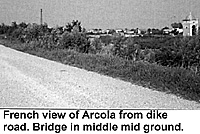 On the 18th Napoleon was about to attack when word reached him that Davidovitch had finally advanced and pushed the French out of Bussolengo and Vaubois had now retreated to Peschiera, he ordered that only the cavalry were pursue Alvinci. Massena was sent to Villanova to support Vaubois and block the Austrian advance. The troops sent by Vaubois were returned and Augereau was ordered to advance on the Austrians via Verona. Davidovitch escaped from the converging columns just in time and he quickly retreated northwards towards the Tyrol.
On the 18th Napoleon was about to attack when word reached him that Davidovitch had finally advanced and pushed the French out of Bussolengo and Vaubois had now retreated to Peschiera, he ordered that only the cavalry were pursue Alvinci. Massena was sent to Villanova to support Vaubois and block the Austrian advance. The troops sent by Vaubois were returned and Augereau was ordered to advance on the Austrians via Verona. Davidovitch escaped from the converging columns just in time and he quickly retreated northwards towards the Tyrol.
Only his rearguard was caught and this was virtually wiped out. Alvinci, discovering that the he was only being pursued by French cavalry, advanced back towards Villanova with the aim of supporting Davidovitch. When he heard of his retreat he turned again and withdrew via Montebello and Vicenza and then further eastwards across the Brenta. Davidovitch took up new positions to the north of Lake Garda while the French held a line from Rivoli to Arcola.
Overall, the third attempt to relieve Mantua had failed. The fortress was still in Austrian hands though matters were becoming desperate for those trapped within its walls, so desperate in fact that they tried to sortie out but were easily beaten back. Napoleon had not reached Villanova as planned but he had kept the two Austrian columns from uniting. He had also forced the Austrians, who outnumbered him, to keep attacking him on ground of his own choosing. Once on equal terms numerically he was able to assume the offensive. Again the courage and marching ability of the French soldiers, along with a commander willing to take risks, had outfought a determined enemy and won the day.
More Arcola:
More in the Series
Back to Table of Contents -- First Empire #24
Back to First Empire List of Issues
Back to MagWeb Master Magazine List
© Copyright 1995 by First Empire.
This article appears in MagWeb (Magazine Web) on the Internet World Wide Web. Other military history articles and gaming articles are available at http://www.magweb.com